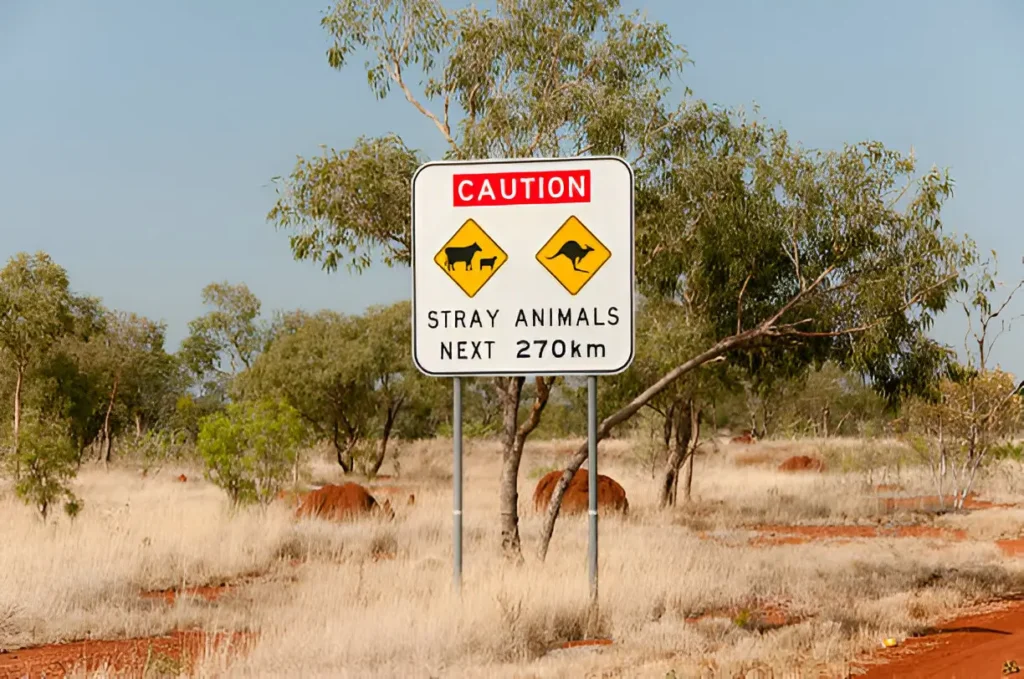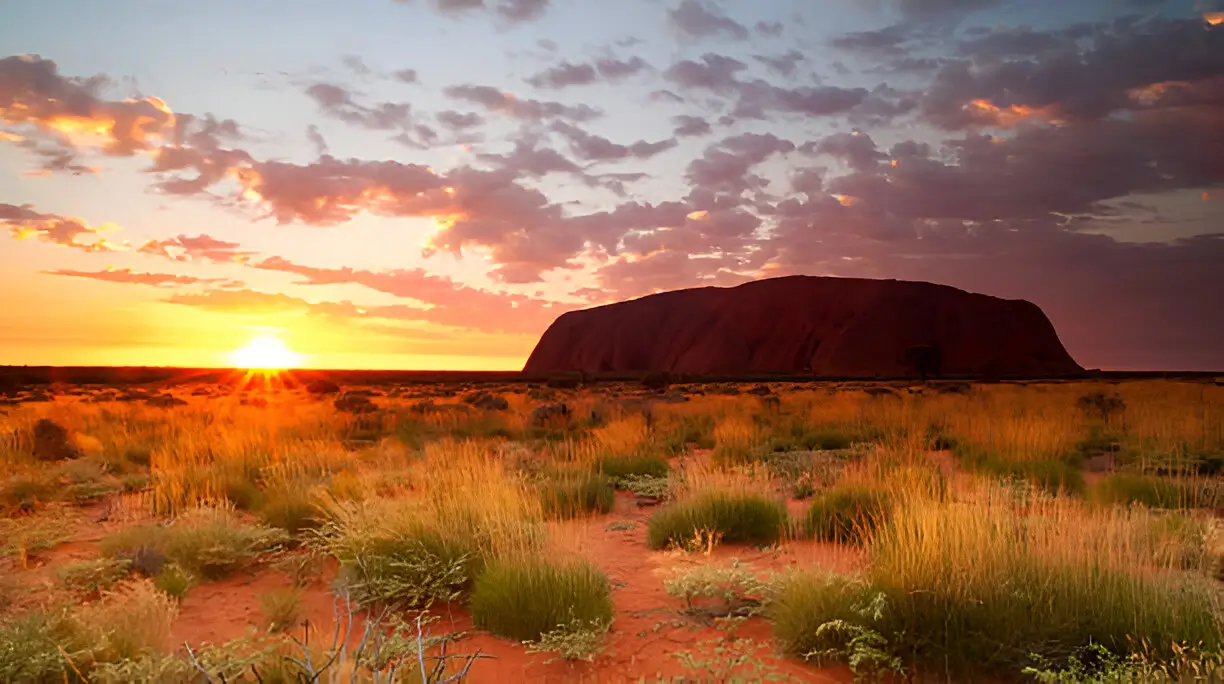Introduction
In this article, we are going to discuss about the best time to visit Uluru in Australia. Uluru, also known as Ayers Rock, is one of Australia’s most iconic landmarks. Located in the heart of the Northern Territory, this massive sandstone monolith is a sacred site for the Anangu people and a bucket-list destination for travelers worldwide. But when is the best time to visit Uluru?
The answer depends on what you want to experience—whether it’s mild temperatures, fewer crowds, or spectacular sunrises and sunsets. This guide will break down the best seasons to visit Uluru, helping you plan the perfect trip.
Best Time to Visit Uluru: A Quick Overview
| Season | Months | Weather | Crowds | Best For |
| Autumn | March – May | Mild (14°C – 30°C) | Moderate | Comfortable hikes, clear skies |
| Winter | June – August | Cool (3°C – 20°C) | High | Best weather, stargazing |
| Spring | September – November | Warm (12°C – 34°C) | High | Desert blooms, wildlife |
| Summer | December – February | Hot (20°C – 40°C) | Low | Fewer tourists, budget travel |
Visiting Uluru in Autumn (March – May)
Weather and Climate
Autumn is one of the best times to visit Uluru. The temperatures range between 14°C and 30°C (57°F – 86°F), making it comfortable for outdoor activities like hiking and sightseeing. The days are warm, and the nights are cool, but not freezing like in winter.
Things to Do
- Base Walks & Hikes: With milder temperatures, it’s a great time to do the Uluru Base Walk (10.6 km).
- Cultural Experiences: Learn about the Anangu culture at the Uluru-Kata Tjuta Cultural Centre.
- Sunrise & Sunset Viewing: Autumn skies are often clear, offering spectacular colors over Uluru.
- Field of Light Exhibition: The famous Bruce Munro’s Field of Light looks stunning under autumn’s crisp night sky.
Crowds & Costs
Autumn sees a moderate number of tourists. Flights and accommodation prices are not as high as in winter but are still above summer rates.
Best for:
- Travelers are looking for pleasant weather.
- Those who enjoy hiking and outdoor activities.
- Photography enthusiasts are seeking clear skies.
Visiting Uluru in Winter (June – August) – Peak Season
Weather and Climate
Winter is considered the best time to visit Uluru due to its mild temperatures. The daytime ranges from 3°C to 20°C (37°F – 68°F), and nights can get quite cold, sometimes dropping below freezing.
Things to Do
- Sunrises & Sunsets: The clear winter skies provide breathtaking color contrasts on Uluru.
- Hiking & Outdoor Activities: The cool temperatures make long hikes around Kata Tjuta (The Olgas) enjoyable.
- Camel Rides & Stargazing: Winter is ideal for stargazing due to low humidity and cloudless skies.
- Wildlife Watching: Expect to see dingos, perentie lizards, and native birds.
Crowds & Costs
Winter is the busiest season, meaning higher prices for accommodation and flights. Booking well in advance is recommended.
Best for:
- Tourists who want to experience Uluru in ideal weather conditions.
- Families, as school holidays bring more visitors.
- Those interested in astronomy and desert wildlife.
Visiting Uluru in Spring (September – November)
Weather and Climate
Spring is another excellent season to visit Uluru. Temperatures range between 12°C and 34°C (54°F – 93°F). While it starts off cool in September, it gets significantly hotter by November.
Things to Do
- See Desert Blooms: Spring is the best time to witness wildflowers bloom across the Red Centre.
- Camel Rides & Helicopter Tours: Enjoy scenic views of Uluru and Kata Tjuta.
- Bushwalks & Rock Art Tours: Learn about ancient Aboriginal rock art at Mutitjulu Waterhole.
Crowds & Costs
Spring is almost as busy as winter. If you want good accommodation, book early. Prices remain high, but not as extreme as the peak winter season.
Best for:
- Nature lovers who want to see Uluru’s desert in bloom.
- Travelers looking for warm (but not extreme) temperatures.
- Adventure seekers are interested in hiking and scenic tours.
Visiting Uluru in Summer (December – February) – Off-Peak Season

Weather and Climate
Summer in Uluru is extremely hot, with daytime temperatures between 20°C and 40°C (68°F – 104°F). Some days, the temperature can reach over 45°C (113°F). It’s also the wet season, bringing occasional storms.
Things to Do
- Sunrise and Sunset Tours: The best way to beat the heat is to explore Uluru early in the morning or late in the evening.
- Helicopter Flights: Get a stunning aerial view of the landscape.
- Cultural Tours: Visit Maruku Arts to experience Aboriginal dot painting workshops.
- Rain over Uluru: If you’re lucky, you might see the rare phenomenon of waterfalls forming on the rock.
Crowds & Costs
Summer is the least busy time, making it the best season for budget travelers. Accommodation and flights are significantly cheaper, and there are fewer tourists at major attractions.
Best for:
- Budget-conscious travelers.
- People who can handle extreme heat.
- Photographers are looking to capture Uluru under unique stormy skies.
Estimated Costs
Daily Costs
- Accommodation: Around $111 (AU$179) per day.
- Meals: Approximately $77 (AU$ 124) per day.
- Local Transportation: About $71 (AU$114) per day.
- Total: Around $176 (AU$ 284) per day.
Weekly Costs
- One Week Trip for One Person: Around $1,232 (AU$ 1,988).
- One Week Trip for Two People: Around $2,465 (AU$ 3,976).
Additional Costs
- Park Pass: $25 for adults, granting three consecutive days of entry.
- Flights: Prices vary, but booking early and visiting during off-peak times is often cheaper.
- Car Hire: Essential for getting around, as public transport is limited.
The cost of flights to Uluru (Ayers Rock) can vary depending on your departure city and travel dates. Here are some approximate one-way prices for economy-class flights:
- From Melbourne: Starting at around AUD 150.
- From Sydney: Starting at around AUD 249.
- From Brisbane: Starting at around AUD 169.
- From Adelaide: Starting at around AUD 259.
- From Perth: Starting at around AUD 409.
These prices are subject to change and may vary based on the airline, time of booking, and availability. It’s always a good idea to book early and compare prices from different airlines.
Final Recommendations: Best Time to Visit Uluru in Australia
- Best Overall Time: Winter (June – August) for ideal weather and clear skies.
- Best for Budget Travelers: Summer (December – February) due to lower prices.
- Best for Adventure & Hiking: Autumn (March – May) when temperatures are mild.
- Best for Wildlife & Flowers: Spring (September – November) for vibrant desert blooms.
If you want the best balance of pleasant weather, fewer crowds, and reasonable prices, March to May (Autumn) is the perfect time to visit Uluru.
FAQs about the Best Time to Visit Uluru in Australia
1. How many days do you need at Uluru?
A minimum of 2 to 3 days is recommended to explore Uluru, Kata Tjuta, and the surrounding cultural attractions.
2. Is Uluru open all year round?
Yes, Uluru is open 365 days a year, but some activities may be restricted in extreme weather conditions.
3. Can you climb Uluru?
No, climbing Uluru is permanently banned as of October 2019, respecting the Anangu people’s wishes.
4. What should I wear when visiting Uluru?
Light, breathable clothing in summer, warm layers in winter, and always a hat, sunglasses, and sunscreen.
5. How do I get to Uluru?
You can fly to Ayers Rock Airport (Connellan Airport) from major Australian cities or drive from Alice Springs (450 km away).
6. Are there any festivals at Uluru?
Yes! The Parrtjima Festival of Light (April) and the Tjungu Festival (April) celebrate Indigenous culture.

